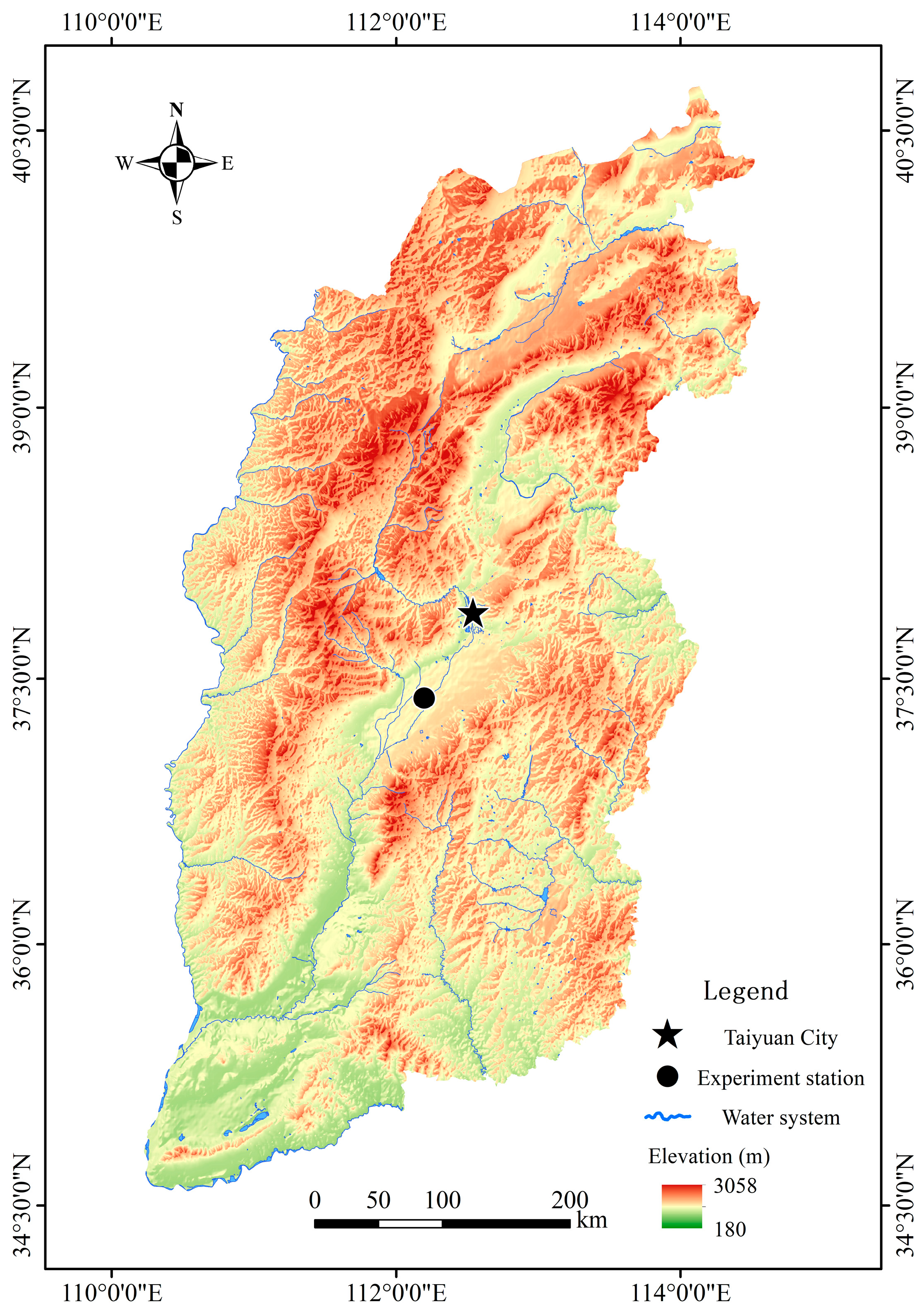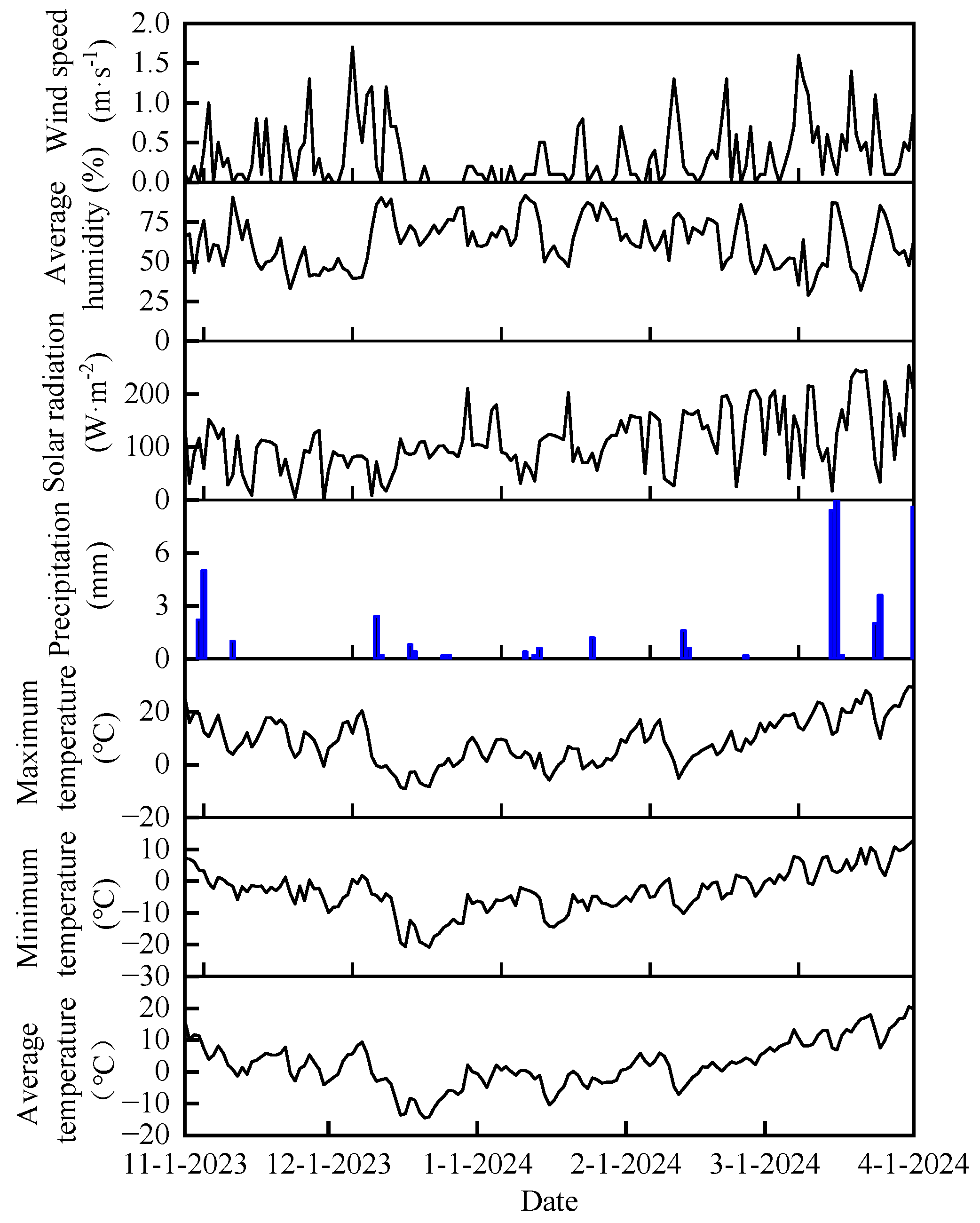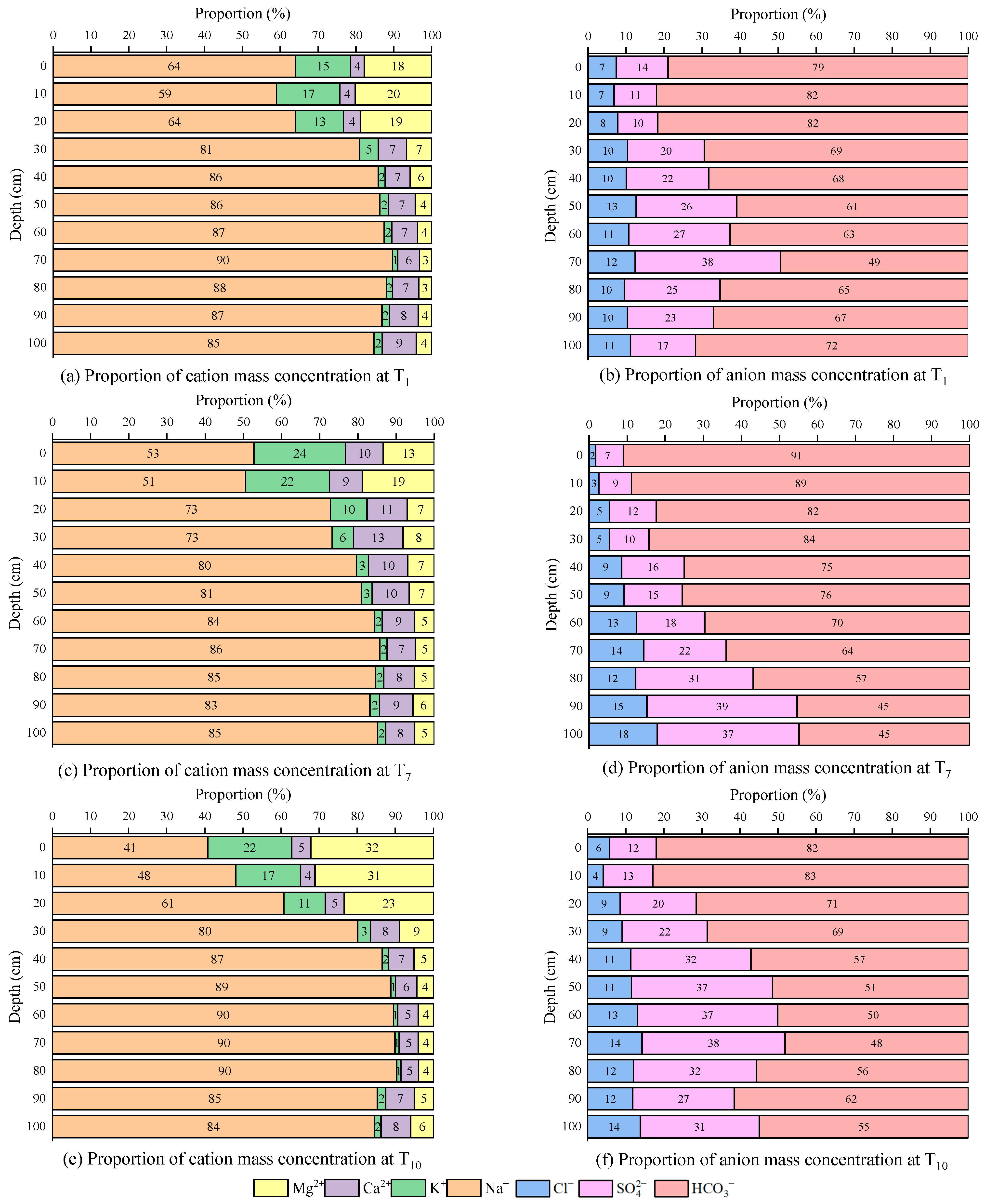Variations in Soil Salt Ions and Salinization Degree in Shallow Groundwater Areas During the Freeze–Thaw Period
Abstract
1. Introduction
2. Materials and Methods
2.1. Overview of the Study Area
2.2. Environmental Conditions
2.3. Experiment Design
2.4. Data Evaluation
3. Results and Discussion
3.1. Soil Temperature During Freeze–Thaw Period
3.2. Variations in Soil Cations and Anion Content During Freeze–Thaw Period
3.3. Migration of Soil Salt Ions During Freeze–Thaw Period
3.3.1. Mass Proportion of Soil Ion
3.3.2. Mass Ratio of Anion and Cation Content Change Between Frozen and Unfrozen Layer
3.4. Analysis on Soil Salinization Degree During the Freeze–Thaw Period
4. Conclusions
Author Contributions
Funding
Data Availability Statement
Acknowledgments
Conflicts of Interest
References
- Ran, Y.; Li, X.; Cheng, G.; Zhang, T.; Wu, Q.; Jin, H.; Jin, R. Distribution of permafrost in China: An overview of existing permafrost maps. Permafr. Periglac. Process. 2012, 23, 322–333. [Google Scholar] [CrossRef]
- Bing, H.; Ma, W. Laboratory investigation of the freezing point of saline soil. Cold Reg. Sci. Technol. 2011, 67, 79–88. [Google Scholar] [CrossRef]
- Wu, T.; Li, H.; Lyu, H. Effect of freeze-thaw process on heat transfer and water migration between soil water and groundwater. J. Hydrol. 2023, 617, 128987. [Google Scholar] [CrossRef]
- Zhang, D.; Wang, S. Mechanism of freeze–thaw action in the process of soil salinization in northeast China. Environ. Geol. 2001, 41, 96–100. [Google Scholar] [CrossRef]
- Chen, L.; Li, C.; Feng, Q.; Wei, Y.; Zhao, Y.; Zhu, M.; Deo, R.C. Direct and indirect impacts of ionic components of saline water on irrigated soil chemical and microbial processes. Catena 2019, 172, 581–589. [Google Scholar] [CrossRef]
- Zhang, Z.; Feng, S.; Luo, J.; Hao, B.; Diao, F.; Li, X.; Jia, B.; Wang, L.; Bao, Z.; Guo, W. Evaluation of microbial assemblages in various saline-alkaline soils driven by soluble salt ion components. J. Agric. Food Chem. 2021, 69, 3390–3400. [Google Scholar] [CrossRef]
- Hou, R.J.; Li, T.X.; Fu, Q.; Liu, D.; Li, M.; Zhou, Z.Q.; Yan, J.W.; Zhang, S. Research on the distribution of soil water, heat, salt and their response mechanisms under freezing conditions. Soil Tillage Res. 2020, 196, 104486. [Google Scholar] [CrossRef]
- Zhao, T.H.; Chen, G.J.; Sun, Q. Effect of sand covering thickness on different tillage state soil water and salt transport law under brackish water irrigation. Appl. Ecol. Environ. Res. 2023, 21, 3319–3333. [Google Scholar] [CrossRef]
- Wang, X.; Li, C.; Shi, Y.; Zhang, Z.; Chi, Q.; Wang, P. Improvements in saline soil and the law of water-salt transport based on salt inhibition using MICP technology. Biogeotechnics 2024, 2, 100055. [Google Scholar] [CrossRef]
- Jiang, D.; Ao, C.; Bailey, R.T.; Zeng, W.; Huang, J. Simulation of water and salt transport in the Kaidu River Irrigation District using the modified SWAT-Salt. Agric. Water Manag. 2022, 272, 107845. [Google Scholar] [CrossRef]
- Zhang, X.; Shu, C.; Fujii, M.; Wu, Y.; Sun, D.A.; Ye, P.; Bao, Y. Numerical and experimental study on water-heat-salt transport patterns in shallow bare soil with varying salt contents under evaporative conditions: A comparative investigation. J. Hydrol. 2023, 621, 129564. [Google Scholar] [CrossRef]
- Bing, H.; He, P.; Zhang, Y. Cyclic freeze-thaw as a mechanism for water and salt migration in soil. Environ. Earth Sci. 2015, 74, 675–681. [Google Scholar] [CrossRef]
- Wan, X.; Gong, F.; Qu, M.; Qiu, E.; Zhong, C. Experimental study of the salt transfer in a cold sodium sulfate soil. KSCE J. Civ. Eng. 2019, 23, 1573–1585. [Google Scholar] [CrossRef]
- Lu, N. Generalized soil water retention equation for adsorption and capillarity. J. Geotech. Geoenviron. Eng. 2016, 142, 04016051. [Google Scholar] [CrossRef]
- Hosseini, P.; Bailey, R.T. Investigating the controlling factors on salinity in soil, groundwater, and river water in a semi-arid agricultural watershed using SWAT-Salt. Sci. Total Environ. 2022, 810, 152293. [Google Scholar] [CrossRef]
- Qin, Y.; Bai, Y.; Chen, G.; Liang, Y.; Li, X.; Wen, B.; Lu, X.; Li, X. The effects of soil freeze–thaw processes on water and salt migrations in the western Songnen Plain, China. Sci. Rep. 2021, 11, 3888. [Google Scholar] [CrossRef]
- Li, X.; Chang, S.X.; Salifu, K.F. Soil texture and layering effects on water and salt dynamics in the presence of a water table: A review. Environ. Rev. 2014, 22, 41–50. [Google Scholar] [CrossRef]
- Rudzianskaite, A.; Sukys, P. Effects of groundwater level fluctuation on its chemical composition in karst soils of Lithuania. Environ. Geol. 2008, 56, 289–297. [Google Scholar] [CrossRef]
- Nordio, G.; Fagherazzi, S. Salinity increases with water table elevation at the boundary between salt marsh and forest. J. Hydrol. 2022, 608, 127576. [Google Scholar] [CrossRef]
- Lyu, H.; Wu, T.; Su, X.; Wang, Y.; Wang, C.; Yuan, Z. Factors controlling the rise and fall of groundwater level during the freezing-thawing period in seasonal frozen regions. J. Hydrol. 2022, 606, 127442. [Google Scholar] [CrossRef]
- Cui, L.; Zhu, Y.; Zhao, T.; Ye, M.; Yang, J.; Wu, J. Evaluation of upward flow of groundwater to freezing soils and rational per-freezing water table depth in agricultural areas. J. Hydrol. 2020, 585, 124825. [Google Scholar] [CrossRef]
- Seeboonruang, U. Relationship between groundwater properties and soil salinity at the Lower Nam Kam River Basin in Thailand. Environ. Earth Sci. 2013, 69, 1803–1812. [Google Scholar] [CrossRef]
- Wan, H.; Bian, J.; Zhang, H.; Li, Y. Assessment of future climate change impacts on water-heat-salt migration in unsaturated frozen soil using CoupModel. Front. Environ. Sci. Eng. 2021, 15, 10. [Google Scholar] [CrossRef]
- Wang, M.; Zhu, Y.; Zhao, T.; Cui, L.; Mao, W.; Ye, M.; Wu, J.; Yang, J. Chemical characteristics of salt migration in frozen soils during the freezing-thawing period. J. Hydrol. 2022, 606, 127403. [Google Scholar] [CrossRef]
- Xue, J.; Huo, Z.; Wang, F.; Kang, S.; Huang, G. Untangling the effects of shallow groundwater and deficit irrigation on irrigation water productivity in arid region: New conceptual model. Sci. Total Environ. 2018, 619, 1170–1182. [Google Scholar] [CrossRef] [PubMed]
- Chhabra, R.; Chhabra, R. Nature and origin of salts, classification, area and distribution of salt-affected soils. In Salt-Affected Soils and Marginal Waters: Global Perspectives and Sustainable Management; Springer: Cham, Switzerland, 2021; pp. 1–47. [Google Scholar]
- Liu, Y.; Wu, J.; Zhao, H.; Li, C.; Mao, J.; Zhang, R.; Liu, J.; Zhao, Q. Ions transport in seasonal frozen farmland soil and its effect on soil salinization chemical properties. Agronomy 2023, 13, 660. [Google Scholar] [CrossRef]
- Guo, K.; Liu, X. Reclamation effect of freezing saline water irrigation on heavy saline-alkali soil in the Hetao Irrigation District of North China. Catena 2021, 204, 105420. [Google Scholar] [CrossRef]
- Shahid, S.A.; Zaman, M.; Heng, L. Introduction to soil salinity, sodicity and diagnostics techniques. In Guideline for Salinity Assessment, Mitigation and Adaptation Using Nuclear and Related Techniques; Springer: Cham, Switzerland, 2018; pp. 1–42. [Google Scholar]
- Wu, J.; Li, P.; Qian, H.; Fang, Y. Assessment of soil salinization based on a low-cost method and its influencing factors in a semi-arid agricultural area, northwest China. Environ. Earth Sci. 2014, 71, 3465–3475. [Google Scholar] [CrossRef]
- Korolyuk, T.V. Specific features of the dynamics of salts in salt-affected soils subjected to long-term seasonal freezing in the south Transbaikal region. Eurasian Soil Sci. 2014, 47, 339–352. [Google Scholar] [CrossRef]
- Yang, F.; An, F.; Ma, H.; Wang, Z.; Zhou, X.; Liu, Z. Variations on soil salinity and sodicity and its driving factors analysis under microtopography in different hydrological conditions. Water 2016, 8, 227. [Google Scholar] [CrossRef]
- Saysel, A.K.; Barlas, Y. A dynamic model of salinization on irrigated lands. Ecol. Model. 2001, 139, 177–199. [Google Scholar] [CrossRef]
- Hassani, A.; Azapagic, A.; Shokri, N. Predicting long-term dynamics of soil salinity and sodicity on a global scale. Proc. Natl. Acad. Sci. USA 2020, 117, 33017–33027. [Google Scholar] [CrossRef]
- Hassani, A.; Azapagic, A.; Shokri, N. Global predictions of primary soil salinization under changing climate in the 21st century. Nat. Commun. 2021, 12, 6663. [Google Scholar] [CrossRef]
- Ding, J.; Wu, M.; Tiyip, T. Study on soil salinization information in arid region using remote sensing technique. Agric. Sci. China 2011, 10, 404–411. [Google Scholar] [CrossRef]
- Sahbeni, G. A PLSR model to predict soil salinity using Sentinel-2 MSI data. Open Geosci. 2021, 13, 977–987. [Google Scholar] [CrossRef]
- Sahbeni, G.; Ngabire, M.; Musyimi, P.K.; Székely, B. Challenges and opportunities in remote sensing for soil salinization mapping and monitoring: A review. Remote Sens. 2023, 15, 2540. [Google Scholar] [CrossRef]
- Sentis, I. Soil salinization and land desertification. In Soil Degradation and Desertification in Mediterranean Environments; Geoforma Ediciones: Logroño, Spain, 1996; pp. 105–129. [Google Scholar]
- Abdi, H.; Williams, L.J. Principal component analysis. Wiley Interdiscip. Rev. Comput. Stat. 2010, 2, 433–459. [Google Scholar] [CrossRef]
- Singh, A. Soil salinization management for sustainable development: A review. J. Environ. Manag. 2021, 277, 111383. [Google Scholar] [CrossRef]
- Gazia, E.A.E.; Gendy, A.A.S.; El-Leithi, A.A.; Ramadan, S.A. The relationship between ESP and SAR at salt affected soils in the North Nile delta. J. Soil Sci. Agric. Eng. 2008, 33, 7713–7718. [Google Scholar] [CrossRef]
- Xie, K.; Cakmak, I.; Wang, S.; Zhang, F.; Guo, S. Synergistic and antagonistic interactions between potassium and magnesium in higher plants. Crop J. 2021, 9, 249–256. [Google Scholar] [CrossRef]
- Swift, R.S.; McLaren, R.G. Micronutrient adsorption by soils and soil colloids. In Interactions at the Soil Colloid—Soil Solution Interface; Springer: Dordrecht, The Netherlands, 1991; pp. 257–292. [Google Scholar]
- Abdi, H. Coefficient of variation. Encycl. Res. Des. 2010, 1, 169–171. [Google Scholar]
- Liu, G.; Wang, J.; Xue, W.; Zhao, J.; Wang, J.; Liu, X. Effect of the size of variable charge soil particles on cadmium accumulation and adsorption. J. Soils Sediments 2017, 17, 2810–2821. [Google Scholar] [CrossRef]
- Song, Y.; Zou, Y.; Wang, G.; Yu, X. Altered soil carbon and nitrogen cycles due to the freeze-thaw effect: A meta-analysis. Soil Biol. Biochem. 2017, 109, 35–49. [Google Scholar] [CrossRef]










| Stage | Tk | Date |
|---|---|---|
| Unstable freezing stage | T1 | 11 November 2023 |
| T2 | 2 December 2023 | |
| Stable freezing stage | T3 | 21 December 2023 |
| T4 | 30 December 2023 | |
| T5 | 14 January 2024 | |
| T6 | 21 January 2024 | |
| T7 | 30 January 2024 | |
| Thawing Stage | T8 | 17 February 2024 |
| T9 | 2 March 2024 | |
| T10 | 13 March 2024 |
| Depth/cm | Soil Bulk Density/g·cm−3 | Porosity | Quality Proportion/% | ||
|---|---|---|---|---|---|
| Sand/0.05–2 mm | Silt/0.002–0.05 mm | Clay/<0.002 mm | |||
| 0~20 | 1.42 | 0.418 | 19.61 | 72.30 | 8.09 |
| 20~40 | 1.55 | 0.373 | 23.24 | 69.77 | 6.99 |
| 40~60 | 1.53 | 0.398 | 28.51 | 64.11 | 7.38 |
| 60~80 | 1.51 | 0.363 | 31.13 | 60.35 | 8.52 |
| 80~100 | 1.42 | 0.446 | 30.26 | 61.79 | 7.95 |
| Depth/cm | Coefficient of Variation (Cv)/% | ||||||
|---|---|---|---|---|---|---|---|
| Na+ | K+ | Ca2+ | Mg2+ | Cl− | SO42− | HCO3− | |
| 0 | 32.59 | 34.16 | 20.03 | 57.42 | 49.23 | 46.24 | 30.07 |
| 10 | 26.09 | 31.19 | 21.38 | 44.39 | 53.22 | 41.51 | 21.77 |
| 20 | 30.78 | 48.46 | 13.78 | 77.34 | 54.42 | 58.63 | 27.86 |
| 30 | 33.29 | 58.02 | 11.75 | 98.15 | 44.71 | 49.45 | 21.89 |
| 40 | 26.44 | 32.07 | 17.95 | 67.89 | 32.59 | 35.40 | 32.35 |
| 50 | 22.72 | 15.57 | 12.46 | 62.69 | 24.12 | 35.46 | 15.56 |
| 60 | 14.87 | 20.30 | 16.31 | 57.38 | 21.64 | 31.67 | 23.76 |
| 70 | 15.53 | 16.86 | 14.90 | 42.67 | 10.90 | 33.70 | 17.24 |
| 80 | 17.60 | 18.72 | 17.16 | 29.06 | 14.39 | 36.40 | 19.13 |
| 90 | 18.03 | 14.81 | 14.84 | 19.67 | 18.09 | 26.48 | 22.50 |
| 100 | 23.58 | 14.04 | 15.19 | 21.60 | 25.28 | 24.24 | 27.32 |
| Factor | Factor Load | Eigenvalue and Variance Percentage | ||||||||||||
|---|---|---|---|---|---|---|---|---|---|---|---|---|---|---|
| TS | Cl− | SO42− | HCO3− | Na+ | K+ | Mg2+ | pH | SAR | ESP | RSC | Eigenvalue | Variance Percentage (%) | Cumulative Percentage (%) | |
| 1 | 0.839 | 0.045 | −0.037 | 0.995 | 0.316 | 0.876 | 0.828 | 0.100 | −0.659 | −0.677 | 0.892 | 5.124 | 40.77 | 40.77 |
| 2 | 0.419 | 0.968 | 0.902 | 0.021 | 0.818 | 0.109 | 0.367 | −0.068 | 0.337 | 0.316 | −0.324 | 3.434 | 27.32 | 68.09 |
| 3 | 0.098 | −0.191 | 0.027 | 0.210 | 0.232 | −0.193 | −0.255 | 0.791 | 0.442 | 0.448 | 0.607 | 2.411 | 19.18 | 87.27 |
| Factor | TS | Cl− | SO42− | HCO3− | Na+ | K+ | Mg2+ | pH | SAR | ESP | RSC |
|---|---|---|---|---|---|---|---|---|---|---|---|
| 1 | 0.160 | −0.011 | −0.027 | 0.200 | 0.058 | 0.175 | 0.160 | 0.019 | −0.142 | −0.145 | 0.185 |
| 2 | 0.128 | 0.337 | 0.316 | −0.014 | 0.235 | 0.020 | 0.111 | −0.027 | 0.131 | 0.124 | −0.133 |
| 3 | 0.055 | −0.116 | 0.016 | 0.123 | 0.167 | −0.119 | −0.157 | 0.476 | 0.268 | 0.272 | 0.362 |
Disclaimer/Publisher’s Note: The statements, opinions and data contained in all publications are solely those of the individual author(s) and contributor(s) and not of MDPI and/or the editor(s). MDPI and/or the editor(s) disclaim responsibility for any injury to people or property resulting from any ideas, methods, instructions or products referred to in the content. |
© 2025 by the authors. Licensee MDPI, Basel, Switzerland. This article is an open access article distributed under the terms and conditions of the Creative Commons Attribution (CC BY) license (https://creativecommons.org/licenses/by/4.0/).
Share and Cite
Han, C.; Meng, Q.; Chen, J.; Cui, L.; Xue, J.; Liu, H.; Yan, R. Variations in Soil Salt Ions and Salinization Degree in Shallow Groundwater Areas During the Freeze–Thaw Period. Water 2025, 17, 2234. https://doi.org/10.3390/w17152234
Han C, Meng Q, Chen J, Cui L, Xue J, Liu H, Yan R. Variations in Soil Salt Ions and Salinization Degree in Shallow Groundwater Areas During the Freeze–Thaw Period. Water. 2025; 17(15):2234. https://doi.org/10.3390/w17152234
Chicago/Turabian StyleHan, Chao, Qiang Meng, Junfeng Chen, Lihong Cui, Jing Xue, Hongwu Liu, and Rong Yan. 2025. "Variations in Soil Salt Ions and Salinization Degree in Shallow Groundwater Areas During the Freeze–Thaw Period" Water 17, no. 15: 2234. https://doi.org/10.3390/w17152234
APA StyleHan, C., Meng, Q., Chen, J., Cui, L., Xue, J., Liu, H., & Yan, R. (2025). Variations in Soil Salt Ions and Salinization Degree in Shallow Groundwater Areas During the Freeze–Thaw Period. Water, 17(15), 2234. https://doi.org/10.3390/w17152234







